As you walk in, your eyes are drawn to a tall, green plant in the corner. This plant can change a room, adding drama and style. It’s a sight that grabs your attention, whether you love plants or are new to them.
Picture a Kentia Palm’s elegant fronds or a Rubber Plant’s shiny leaves in your living room. These plants do more than look good; they clean the air and make you feel better. Starting your search for the perfect tall indoor plant opens up a world of beauty and personality.
There’s the bold Fiddle-Leaf Fig and the tough Snake Plant, among others. But picking the right one for your home can be tricky. Don’t worry, we’ll show you how to find and care for the best tall indoor plant. It will make your home lively and impress everyone who visits.
Table of Contents
Why Choose Tall Indoor Plants?
Bring a new level of beauty to your home with sky-high interior foliage. These soaring home botanicals are not just eye-catching. They also bring many benefits that can change how you live.
Benefits of Adding Height to Your Space
Tall indoor plants, like the statuesque living plant, can fill empty spots and be a room’s centerpiece. They make a space look bigger and feel more open. Plus, they help clean the air, add moisture, and create a peaceful vibe.
Enhancing Aesthetic Appeal
Tall indoor plants also make your decor look more elegant and classy. Their tall height and lush leaves make any room look more luxurious. They can make a small area look bigger and more welcoming, whether in a living room or by the entrance.
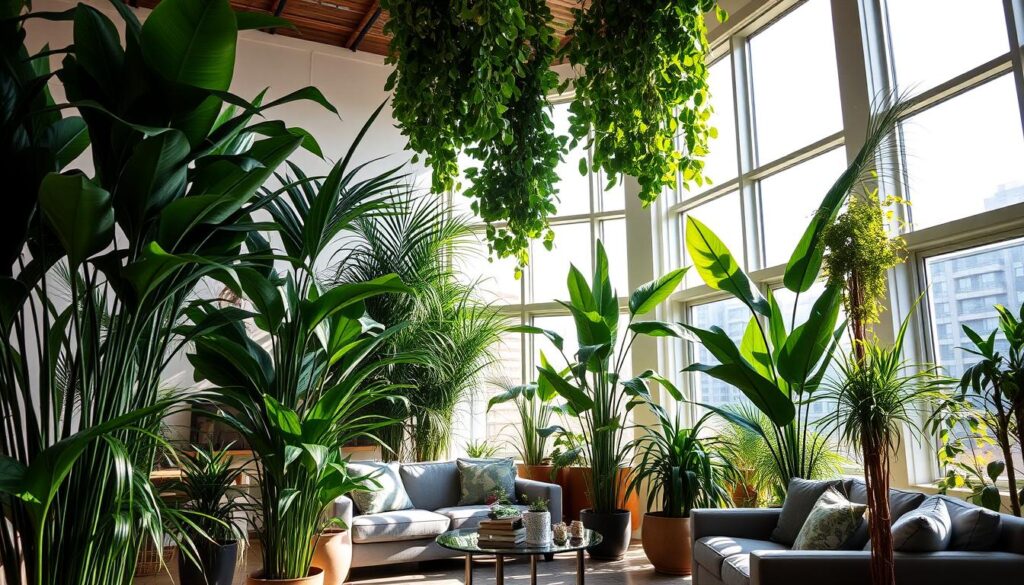
“Tall indoor plants can instantly transform a space, adding a sense of grandeur and bringing the outdoors in.”
| Plant | Maximum Height |
|---|---|
| Snake Plant | 3 feet |
| ZZ Plant | 3 feet |
| Heart Leaf Philodendron | 10 feet |
| Dragon Tree | 20 feet |
| Pothos | Trailing vines |
Top Tall Indoor Plants for Beginners
Discover the stunning potted plants that can turn your home into a lush botanical paradise. If you’re new to indoor plants, these three tall beauties are great for starting your journey.
Fiddle Leaf Fig
The Fiddle Leaf Fig (Ficus lyrata) is a standout, with leaves shaped like violins that can grow up to 6 feet tall. It loves bright, indirect light and needs regular watering. This makes it perfect for beginners.
Rubber Plant
The Rubber Plant (Ficus elastica) is easy to care for, growing up to 6 feet tall with its shiny, dark green leaves. It grows fast and does well in different light conditions. It’s a great choice for beginners who want a big, impressive plant.
Snake Plant
The Snake Plant (Sansevieria), or “Mother-in-Law’s Tongue,” is tough and simple to care for. The Moonshine variety has silver leaves that can grow up to 4 feet tall. It thrives in bright, indirect light and needs little water.
These three plants are a great starting point for beginners. With the right care, they can add a touch of nature’s beauty to your home or office.
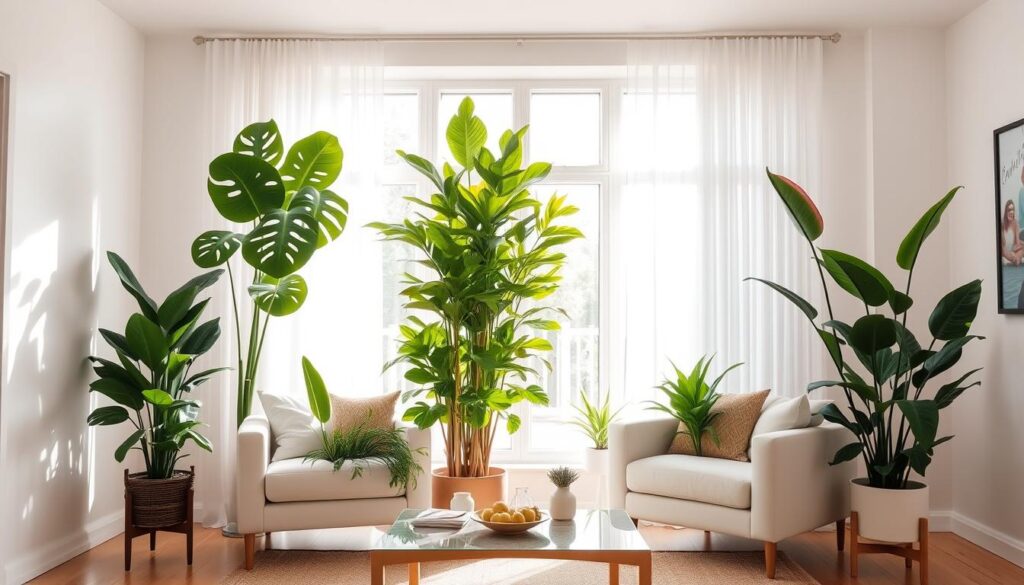
Ideal Conditions for Tall Indoor Plants
For tall indoor plants to thrive, the right environment is key. This includes the right light and temperature. Knowing what your plant needs helps it grow well over time.
Light Requirements
Plants like the Fiddle Leaf Fig and Rubber Plant love bright, indirect light. They do best in spots with lots of sunlight but not too much. The Norfolk Island Pine can handle less light, making it great for dimmer rooms.
Humidity Levels
Humidity needs vary among tall plants. Ferns and Monsteras need humid air, above 50%. But Yucca plants can handle drier air, perfect for dry homes or offices.
Temperature Preferences
Most tall plants like temperatures between 60-75°F (15-24°C). Keep them away from cold drafts and heat sources. A steady, comfortable temperature keeps them healthy and happy.
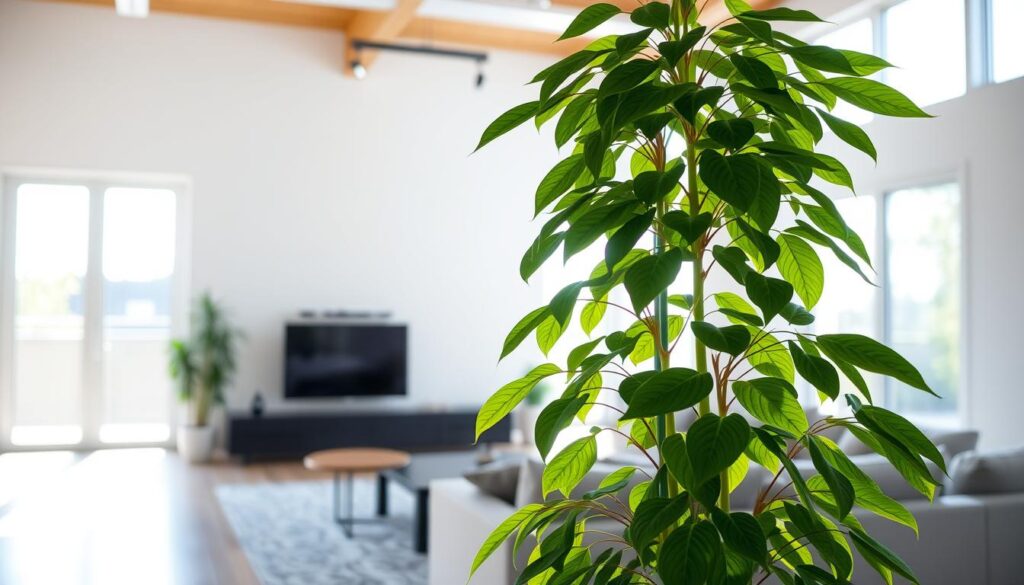
“Providing the right conditions for your tall indoor plants is essential for their long-term growth and vibrancy.”
How to Care for Your Tall Indoor Plant
Adding lofty indoor greenery to your home can change its feel and look. To keep your sky-high interior foliage healthy, you need to know how to care for it. This includes watering, pruning, and regular upkeep. Let’s look at the key steps to care for your soaring home botanical.
Watering Guidelines
How much water your tall indoor plant needs depends on its type. Generally, let the soil dry a bit before watering again. This stops root rot and fungal growth. Check the soil by sticking your finger into it. If the top inch or two is dry, it’s time to water.
Fertilization Tips
In spring and summer, give your plants a balanced fertilizer. This boosts their growth and keeps their leaves green. Use the fertilizer as directed on the label. Don’t overdo it, as too much can harm your plants.
Pruning and Maintenance
- Prune your plants often to keep them looking good and growing. Use sharp shears to cut off dead or damaged parts.
- Wipe the leaves with a damp cloth to remove dust. This also helps air move better and keeps pests away.
- Repot your plant every 2-3 years when the roots outgrow the pot. Move it to a slightly bigger pot with fresh mix.
By following these care tips, your lofty indoor greenery, sky-high interior foliage, and soaring home botanical will flourish. They will make your home look and feel better.
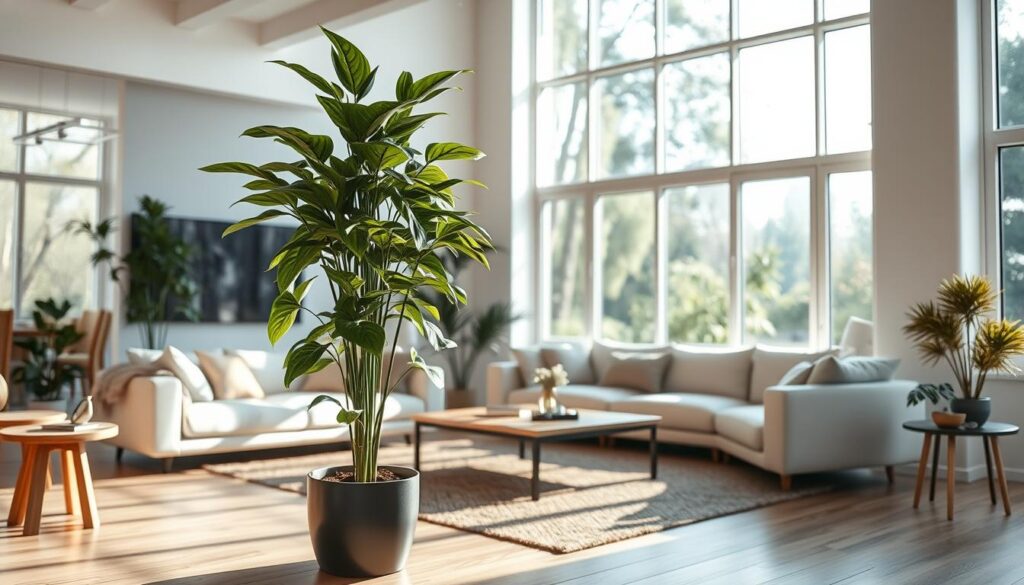
Creating a Stunning Indoor Plant Display
Make your indoor space come alive with statuesque living plants, monumental indoor flora, and majestic potted verdure. Improve your home’s look by arranging plants of different heights. This creates a beautiful and balanced display.
Arranging Plants by Height
Place your tall indoor plants as the main attraction. Surround them with shorter plants for a layered look. Taller plants can be eye-catching centerpieces or frame your furniture. Smaller plants fill gaps and add depth.
Using Decorative Pots
Match your monumental indoor flora with decorative pots that show your style. Choose from modern to rustic pots. The right pot can make your plants look even better and unite your display.
Grouping with Smaller Plants
Pair your statuesque living plants with smaller plants for a balanced display. The mix of sizes and shapes adds depth and interest to your garden.
“Indoor gardening has evolved into an art form, with creating beautiful indoor gardens becoming more fashionable as rare and exotic species gain appeal.”
Try out different setups and colors. Move your plants until you find the perfect spot. With creativity, you can turn your space into a lush oasis that delights everyone.
Best Locations for Tall Indoor Plants
Adding tall indoor plants to your home is a great idea. They bring depth, height, and a natural touch to any room. Let’s find the best spots for these impressive plants.
Living Room Opportunities
The living room is perfect for tall plants. Place them in corners or behind sofas for depth and interest. They can also divide open-plan areas, keeping things open and airy.
Popular choices include the India Rubber Fig, Dracaena, and the White Bird of Paradise. These plants make a bold statement.
Home Office Benefits
A tall plant in your home office boosts productivity and well-being. They improve air quality, reduce stress, and add a professional touch for video calls. Think about a Parlor Palm or a Kentia Palm for elegance and a touch of the exotic.
Choose a plant that fits your space, lighting, and humidity. The right plant in the right spot can turn any room into a lush oasis.
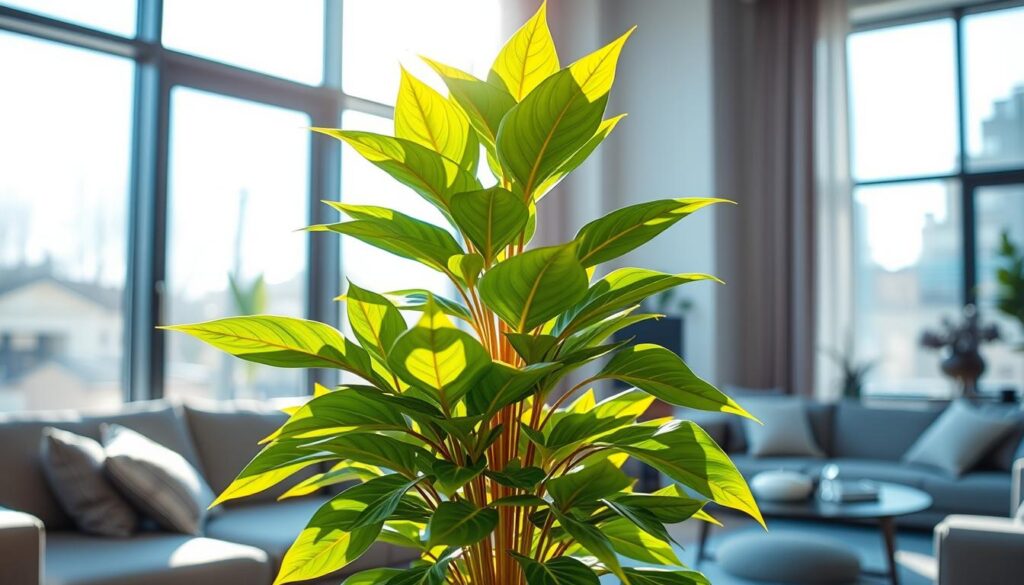
Common Pests and Issues
Towering potted plants and lofty indoor greenery can make any space look amazing. But, they can also face common pests and issues. As a responsible caretaker, it’s important to watch out and fix problems quickly.
Identifying Pests
Common pests include spider mites, mealybugs, and scale insects. Look for signs like discolored leaves, sticky residue, or visible insects. These are signs of an infestation.
Natural Remedies
- Neem oil is a natural insecticide that fights many pests.
- Insecticidal soap is a gentle yet effective solution for pests.
- Wiping leaves with a diluted alcohol solution can remove pests and their eggs.
To avoid problems, keep watering and humidity right. Also, check your plants often for early signs of trouble.
| Pest | Identification | Natural Remedies |
|---|---|---|
| Spider Mites | Tiny spider-like insects that leave behind webbing and cause discoloration | Neem oil, insecticidal soap, wiping leaves with diluted alcohol |
| Mealybugs | White, cottony insects that cluster on stems and leaves | Neem oil, insecticidal soap, wiping leaves with diluted alcohol |
| Scale Insects | Hard, brown, oval-shaped insects that attach to leaves and stems | Neem oil, insecticidal soap, wiping leaves with diluted alcohol |
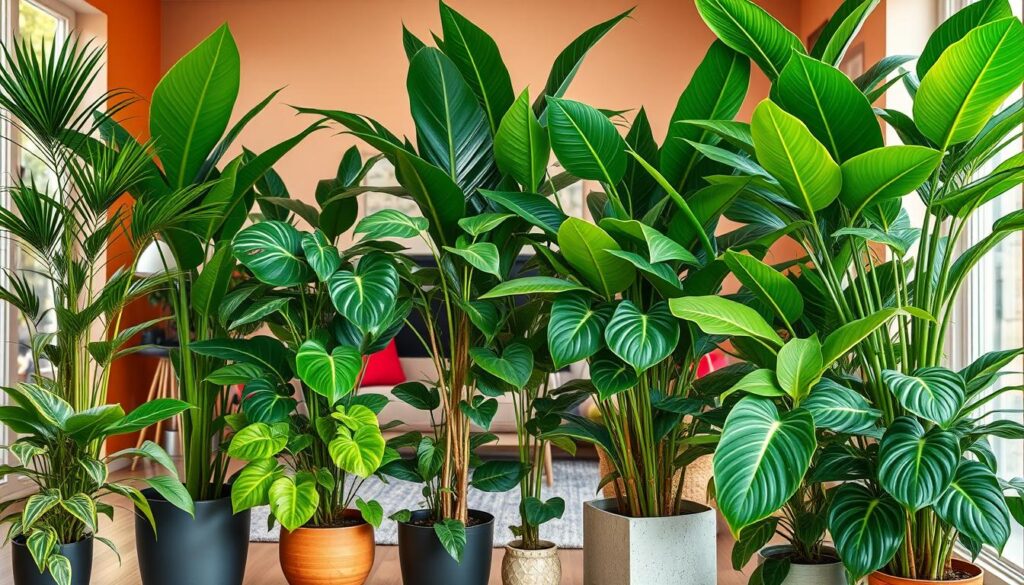
Decorating Tips with Tall Indoor Plants
Adding tall indoor plants to your home decor can make a big impact. These plants can grow up to 10 feet tall and have leaves up to 12-18 inches long. They can fill empty spaces and balance your furniture, blending nature with your design.
Balancing Scale with Furniture
Think about your furniture’s size when adding tall plants. Big sofas or chairs look great with a tall plant nearby. It creates a nice balance. You can also use these plants to fill corners or draw the eye up, adding depth.
Incorporating Plants into Design Schemes
- Tropical homes love a Strelitzia nicolai (Bird of Paradise) or Monstera deliciosa for lush foliage.
- Minimalist spaces benefit from a Ficus lyrata (fiddle-leaf fig) or a Kentia Palm for elegance.
- Bohemian interiors are enhanced by a Monstera deliciosa’s wild, cascading leaves.
Tall indoor plants bring color, texture, and life to any room. Choose plants that fit your style and leave enough space for them to grow. This way, they won’t crowd your furniture or walls.
Propagating Tall Indoor Plants
Adding tall indoor plants to your home brings a touch of elegance. You can also grow more of these plants to fill your space. Let’s look at how to multiply your favorite tall indoor plants.
Methods of Propagation
There are a few ways to grow more tall indoor plants. Each method has its own benefits. Here are the most common ones:
- Stem Cuttings: Cut a healthy stem from the plant, leaving the lower leaves off. Place the cutting in water or soil that drains well.
- Air Layering: Wrap a stem section in moist sphagnum moss, then cover it with plastic. Roots will grow, letting you separate the new plant.
- Division: Split the plant’s root ball carefully. Make sure each part has its own roots and leaves.
Timing and Tips
The best time to grow more plants is in spring and summer. This lets them grow strong before the cold months. Use clean tools to avoid disease. A rooting hormone can help your stem cuttings grow, especially for tricky plants like the Ficus.
“With a little care and attention, you can easily multiply the presence of your majestic potted verdure and create a colossal interior botanical display in your home.”
Seasonal Care for Tall Indoor Plants
Keeping your tall indoor plants healthy all year needs some seasonal tweaks. As seasons change, adjust your care to keep your plants thriving indoors.
Seasonal Adjustments
In winter, plants grow slower, so water and fertilize less. Avoid overwatering to prevent root rot. Only water when the top inch or two of soil feels dry. Also, wait until spring to fertilize, as plants need less during this time.
The dry winter air can harm your plants. Boost the humidity around them. Use a pebble tray, mist leaves, or a small humidifier to keep moisture right.
Protecting from Extremes
Keep your plants away from cold drafts and sudden temperature changes. Move them from windows, heating vents, and cold air sources. In summer, protect them from direct sunlight to prevent leaf scorch.
If it’s warm enough, move your plants outside for the summer. Start with a few hours of morning sun. Gradually increase their outdoor time until they adjust fully.
“Seasonal care is the key to keeping your large houseplants thriving year-round. With a little extra attention, you can ensure your towering potted plants remain vibrant and stunning in your indoor oasis.”
Myths About Tall Indoor Plants
Adding sky-high plants to your home can be exciting. But, there are myths that might stop you. Knowing the real needs of these plants can help you create a beautiful, easy-to-care-for space.
Debunking Common Misconceptions
Many think all tall plants need constant pruning. But, plants like the Fiddle Leaf Fig or Rubber Plant are naturally tidy. They only need occasional trimming to keep their shape.
Another myth is that tall plants need big pots. While some do, others like the Snake Plant do better in smaller pots. They thrive in modestly sized containers.
Understanding Their Needs
- Light needs vary among tall plants. Some love bright sunlight, while others prefer indirect light.
- Humidity is important too. Some plants need misting, but not all.
- Temperature preferences differ. Some plants like it cooler, while others prefer warmer.
Research each plant’s needs before choosing. This way, you can provide the best conditions for their growth. By doing this, you’ll have a stunning, easy-to-care-for space.
Where to Buy Tall Indoor Plants
Looking for monumental indoor flora? You have a few options. Local nurseries are a great start. They let you see the plants in person and get advice from experts. This is especially helpful for those new to colossal interior botanical.
Local Nurseries vs. Online Retailers
Online stores like Green Bubble offer a wide range of tall indoor plants. They deliver right to your door, making it easy. Just check the plant when it arrives to make sure it’s healthy.
Tips for Healthy Plant Selection
It’s key to check plants carefully before buying, no matter where you shop. Look for pests or disease, check the leaf color and firmness, and make sure the plant is well-rooted. Also, think about the plant’s size and growth rate to fit your space and home environment.
FAQ
What are the benefits of adding tall indoor plants to my home?
Tall indoor plants can change your living space for the better. They add height and drama, making your home look more beautiful. They also help clean the air, increase humidity, and make your home feel calmer.
Big plants like the Majesty Palm can clean the air in small spaces. They make small areas feel bigger and add a touch of luxury.
What are some popular options for tall indoor plants?
Popular tall indoor plants include the Norfolk Island Pine, Rubber Plant, and Fiddle-Leaf Fig. These plants can grow up to 6-8 feet tall indoors.
What are the light, humidity, and temperature requirements for tall indoor plants?
Most tall indoor plants like bright, indirect light. Some, like the Norfolk Island Pine, can handle low light. Ferns and Monsteras need high humidity, while Yucca plants can handle low humidity.
Most plants do well in temperatures between 60-75°F (15-24°C). Avoid placing them near drafts or heat sources.
How do I care for my tall indoor plant?
Watering needs vary by plant. Let the soil dry between waterings. Fertilize in spring and summer with a balanced fertilizer.
Prune regularly to keep the plant looking good. Clean leaves to remove dust. Repot every 2-3 years or when the roots outgrow the pot.
How can I create a visually appealing display with tall indoor plants?
Arrange plants of different heights for interest. Use tall plants as centerpieces or to frame furniture. Choose pots that match your decor.
Group tall plants with smaller ones for a lush look. Pick plants with different leaf shapes and colors for more appeal.
Where are the best places to put tall indoor plants in my home?
In living rooms, place tall plants in corners or behind sofas. They add depth. Use them to separate areas in open-plan spaces.
In home offices, tall plants improve air quality and reduce stress. Place them near windows or in areas visible during video calls for a professional look.
How do I deal with pests on my tall indoor plant?
Common pests include spider mites, mealybugs, and scale insects. Look for discolored leaves, sticky residue, or visible insects.
Use natural remedies like neem oil, insecticidal soap, or wiping leaves with diluted alcohol. Prevent pests by keeping the right watering and humidity levels and regularly checking your plants.
Can I propagate my tall indoor plant?
Yes, you can propagate tall indoor plants through stem cuttings, air layering, and division. The best time is during the growing season (spring and summer).
Use clean, sharp tools to prevent disease. For stem cuttings, root in water or moist soil. Some plants, like Ficus, benefit from rooting hormone.
How do I care for my tall indoor plant during different seasons?
In winter, reduce watering and fertilizing as growth slows. Increase humidity in dry winter months. Move plants away from cold drafts and heating vents.
In summer, protect from direct sunlight and increase watering if needed. Consider moving plants outdoors during warm months, gradually acclimating them.
Are there any myths or misconceptions about tall indoor plants?
Yes, some think all tall plants need constant pruning or are hard to maintain. But many are actually low-maintenance. Not all tall plants need large pots; some prefer to be slightly root-bound.
Understand each plant’s specific needs rather than applying general rules to all tall plants.
Where can I purchase high-quality tall indoor plants?
Local nurseries let you see plants in person and get expert advice. Online retailers like Green Bubble offer a wider selection and convenient delivery.
When selecting, check for pests, examine leaf color and firmness, and ensure the plant is well-rooted. Consider the plant’s mature size and growth rate for your space.

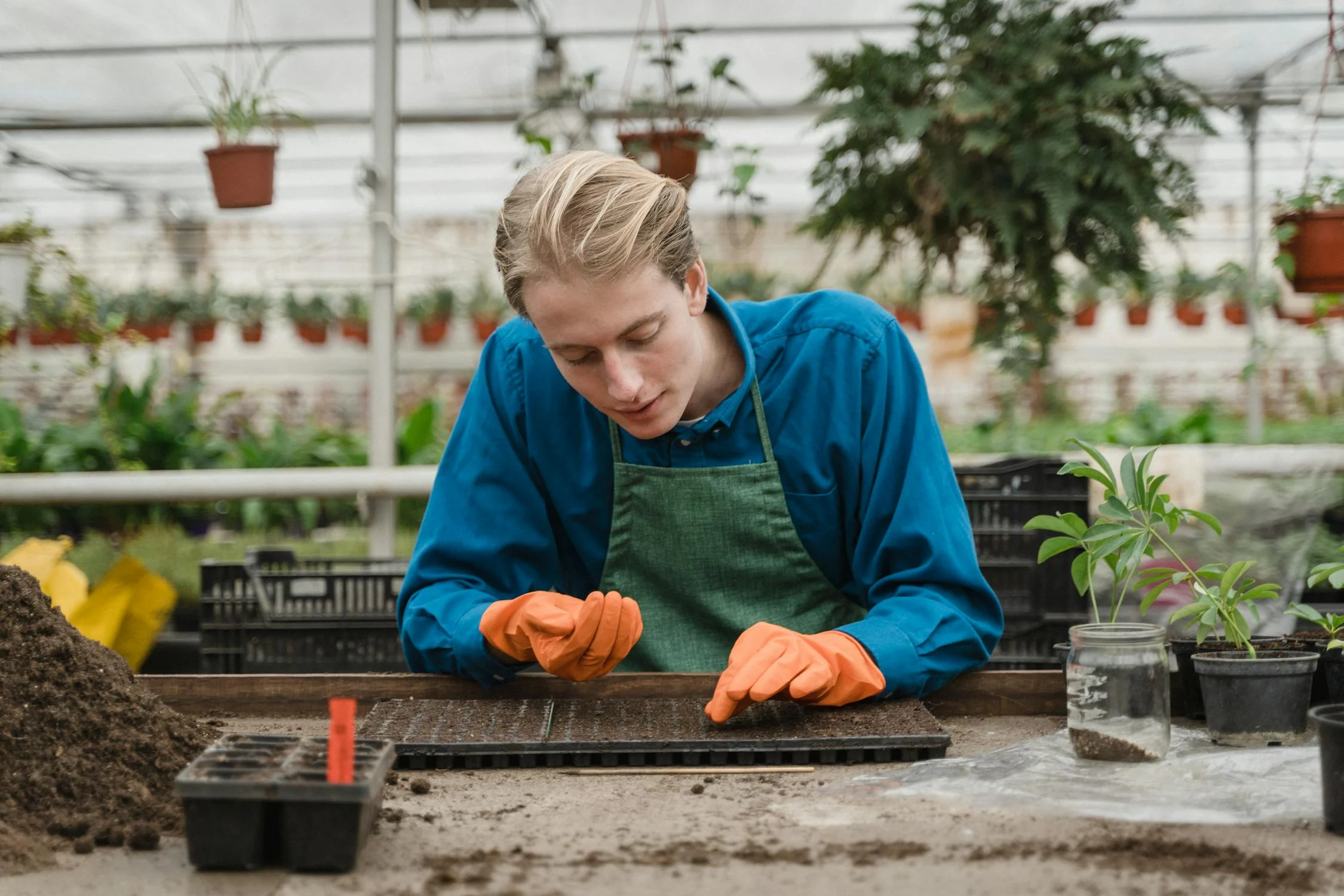
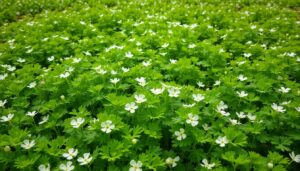
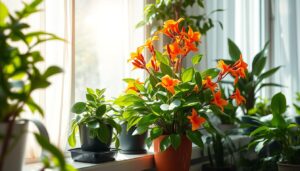







1 thought on “Discover the Best Tall Indoor Plant for Your Home”